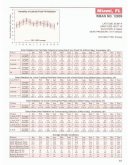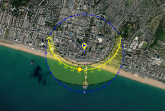Hmmm, did I mention I'm not an expert? It should be fairly close.
In the example above, the 10 degrees is offset from the sun's angle, so if the sun was at 40 degrees it assumes the panels were at 30 or 50 degrees from level.
So, let's use some data from the calculator and see how it does. We'll use Cambridge which has a latitude of 52.2. The Earth's tilt is 23.5 degrees, so in winter the sun is at 52.2+23.5 degrees to summer at 52.2 - 23.5 degrees, or 75 to 28 degrees. From the calculator at 23 degrees insolation is 1.08 for Dec and 4.7 for July. At 53 degrees the insolation is 4.7 for Jul and 1.16 for Jan. At 38 degrees insolation is 1.05 for dec and 4.28 for July.
So, at 23 degrees in winter the tilt is 0 relative to the sun. In Dec at 23 degrees it's perpendicular to the sun, so with out hypotethetical 1kW array: 1.08 x 1 = 1.08, is the maximum possible energy. To convert to 38 degrees, is 38-23=15 degrees. Cosine of 15 is 96.5%. 1.08 x 96.5% = 1.043

that's pretty close to 1.05.
Let's go the other way. At 53 degrees in July is the maximum energy at 4.7. So, to go to 38 degrees is an offset of of 15 degrees.
4.7 x 96.5% = 4.5

So that's off... should have been 4.28.
Ah shoot... I know what it is, even
posted about it today. There's an "edge effect" that's more predominant in summer than winter that makes the morning/evening angles steeper and would through the calculations off more in summer. That's probably going to be a pain to figure out.
You can see why I use SAM.







